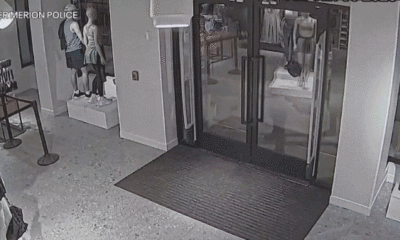Entertainment
Adapting 'Lady in the Lake' for TV meant centering the women at the core of the story
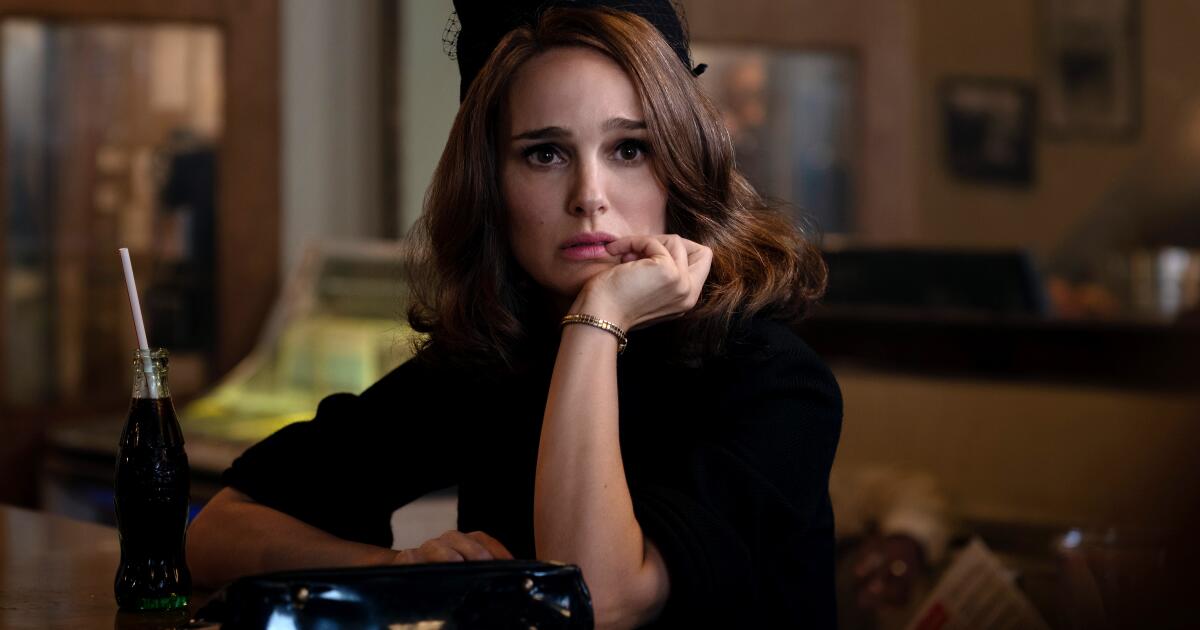
The seeds of “Lady in the Lake” were planted in 1969 with the disappearances and deaths of an 11-year-old Jewish girl and a 33-year-old Black woman in Baltimore. These crimes inspired Laura Lippman to write her 2019 novel, in which multiple narrators tell the stories of aspiring newspaper reporter Maddie Schwartz, a Jewish woman trying to establish herself as a journalist as she breaks away from her traditionalist family; and Cleo Sherwood, a Black waitress who gets on the wrong side of her criminal employers.
Now “Lady in the Lake” has been adapted into a seven-episode limited series, created by Alma Har’el and premiering Friday on Apple TV+. The story, about women pushing against hard glass ceilings, a city on the brink, and the different ways that different people look for freedom, has undergone significant changes on the path from the streets of Baltimore to the pages of a bestseller and now to the screen. In separate interviews, Lippman, Har’el and members of the cast, including stars Natalie Portman and Moses Ingram, shared their thoughts about bringing “Lady” to life.
The novelist
Lippman is a Baltimore native and former reporter at the Baltimore Sun. As a child, she read about Esther Lebowitz, an 11-year-old girl who in 1969 went missing and was later found dead. But it wasn’t until Lippman went to work at the Sun that she learned of Shirley Parker, the Black woman who received almost no coverage in the city’s white, mainstream press when her decomposed body was found in a lake fountain soon thereafter.
“I grew up reading the newspaper, but I had to go work at the newspaper and take the rewrite guys’ tour of Baltimore to find out about the Lady in the Lake,” she said in an interview from her Baltimore home. “I was very much interested in the idea that a little girl died and everybody knew, and a Black woman died, and we’ve never even had an official cause of death. They’ve never even been able to rule it a homicide, and at this point, there’s not going to be any determination made in that death.”
This discrepancy fascinated Lippman. But she didn’t want to just write a novel about these two deaths. When she writes fiction, she doesn’t do deep research into specific cases.
“I don’t reach out to the real-life families who might have connections to these cases because I don’t want to inflict pain,” Lippman said. “I’m thinking about this all the time. There have been some crime podcasts that do this that I have really had trouble with.”
Instead, she set out to write a novel with a very specific theme: “I decided to go really meta and write a story about a white woman who exploits Black pain for her own gain.”
Moses Ingram, left, stars as Cleo Johnson and Byron Bowers as her husband, Slappy Johnson, in “Lady in the Lake.”
(Apple)
Enter Maddie, played in the series by Portman — in her first recurring TV role — and Cleo, played by Ingram (“The Queen’s Gambit”), whose surname is Johnson in the adaptation. The disappearance of the little girl sends Maddie into an existential tailspin. She leaves her husband, moves into a predominantly Black neighborhood and rekindles an old passion for journalism. She grows increasingly obsessed with the missing girl, and then with Cleo, who chides Maddie, perhaps from the grave, for missing the big picture.
“Lady in the Lake” plays differently on the screen than on the page — Maddie is a little more redeemable in the series than in the novel — and the myriad narrative voices in the book have given way to a dialogue of sorts between Maddie and Cleo.
Lippman, who calls the series “terrific,” has no problem with such changes. The author, who was married to David Simon, creator of the quintessential Baltimore series “The Wire,” said she knows a lot about how TV is made but that she doesn’t write for the screen.
“I don’t think of it as my story anymore,” Lippman said. “I didn’t from the moment I sold it. I come to adaptation as a novelist.”
The creator
Har’el, who was born and raised in Israel but is now a longtime Los Angeles resident, was struck by how the story handled Maddie’s Jewish identity when the project was first brought to her by producers Nathan Ross and the late Jean-Marc Vallée.
“The idea of Jewishness creates an opportunity to explore persecution, racism, and both oppression and being an oppressor,” she said in a video interview from her Los Angeles home. “It also lets you look at assimilation, or having the possibility to even assimilate.”
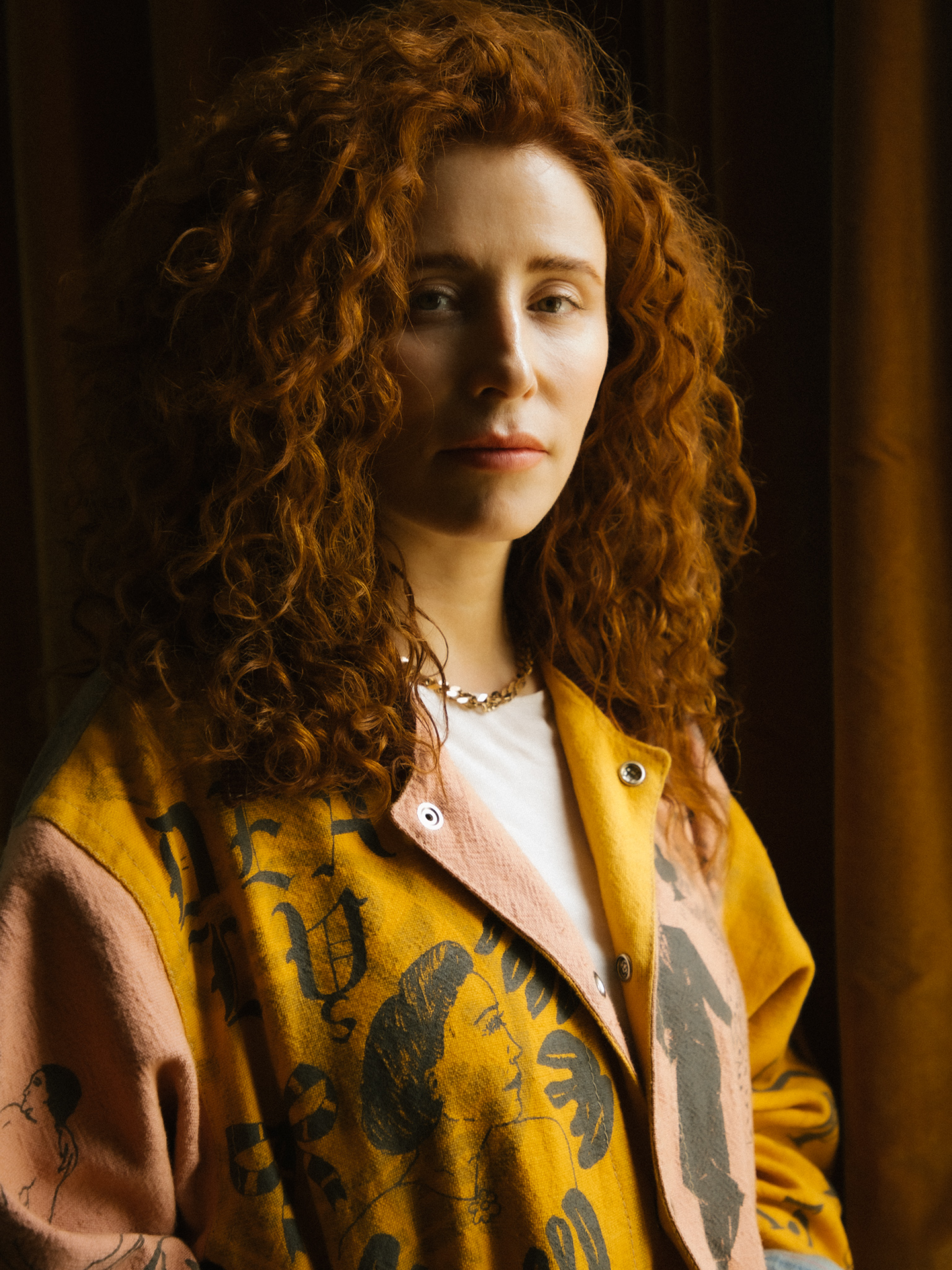
Alma Har’el, creator, writer and director of Apple TV+’s “Lady in the Lake.”
(Rob Berry)
These ideas swirl around Maddie, whose family eats kosher and observes the high holidays, and who rebels against her culture’s expectations of her as a wife and mother.
But the Black characters in “Lady in the Lake” intrigued her as well, particularly the different ways they represent the idea of freedom. Har’el’s romantic partner, comedian Byron Bowers, inspired her to create a husband for Cleo, Slappy “Dark” Johnson, whom he plays in the series. Slappy is a Richard Pryor-like comic testing creative boundaries in the mid-‘60s (both novel and series take place in 1966) and exploring topics that resonate within the Black community. Bowers was also a consulting producer on the series, and several of the series’ writers are Black.
“Everybody in the series is fighting their own war inside, and finding freedom outside of what society says, which is something I try to do in real life,” Bowers said in a separate interview. “This is a world of Black people I didn’t even know. I came up in the crack epidemic. But this is when families still were families and Black people had hope before heroin and the Vietnam War.”

Tyrik Johnson, left, and Byron Bowers in “Lady in the Lake.”
(Apple)
Where Lippman’s novel incorporates multiple narrators, some more reliable than others, Har’el immediately zoomed in on the voices of Cleo and Maddie, two women desperately trying to break free of the strictures created by a very patriarchal society. Maddie can’t even sell her own car without her soon-to-be-ex-husband’s signature; Cleo lives largely under the thumb of her gangster/club owner boss, played by Wood Harris, who combines Black Power rhetoric with a ruthless command of the city’s numbers racket.
Har’el, who was the lead writer and also directed all seven episodes of the series, sees the characters as part of the same push-pull duality that fuels the entire story.
“There’s a Jungian underbelly going on in the show that is trying to seduce you to maybe see beyond the politics of it all and into human experience,” she said. “It turns that experience into something that, hopefully, the characters get to touch.”
But without her stars, she says, the ideas mean little.
“The credit goes to the actors,” she says. “They come to that emotional place with authenticity, and it’s pretty magical to see them do that.”
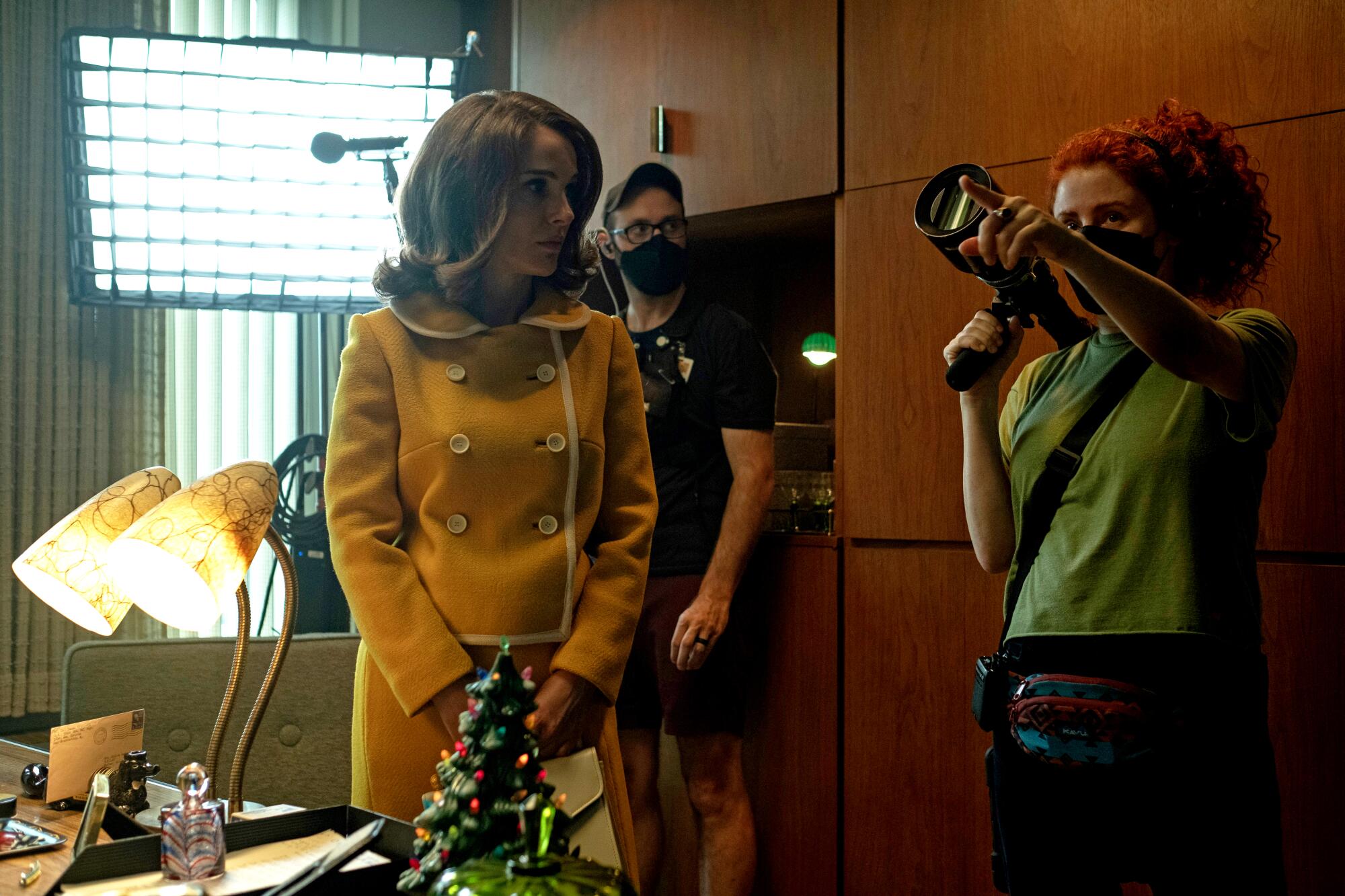
Natalie Portman, left, on set with Alma Har’el.
(Apple)
The stars
Portman was attached to the project from the beginning, as a star and executive producer. At one point Lupita N’yongo was slated to play Cleo, but the character ultimately wasn’t cast until shooting had commenced; “Nobody could agree,” Har’el says. “But when Moses came in, it was so clear. Everybody saw it right away.”
Ingram and Portman rarely appear on screen together, but they’re linked from the moment they see each other in the first episode. In the opening scenes, blood from the lamb that Maddie has purchased for her family’s dinner has spilled onto her dress, and she eyes the outfit that Cleo is modeling in the window of a department store. For Portman, this moment speaks volumes.
“In that initial scene of them together, where she’s looking at Cleo in the dress, she’s really just looking at the dress,” Portman said in a video interview alongside Ingram. “It’s kind of symbolic of how she treats Cleo. She’s using her as a vehicle for her own needs and to further her own ambition.”
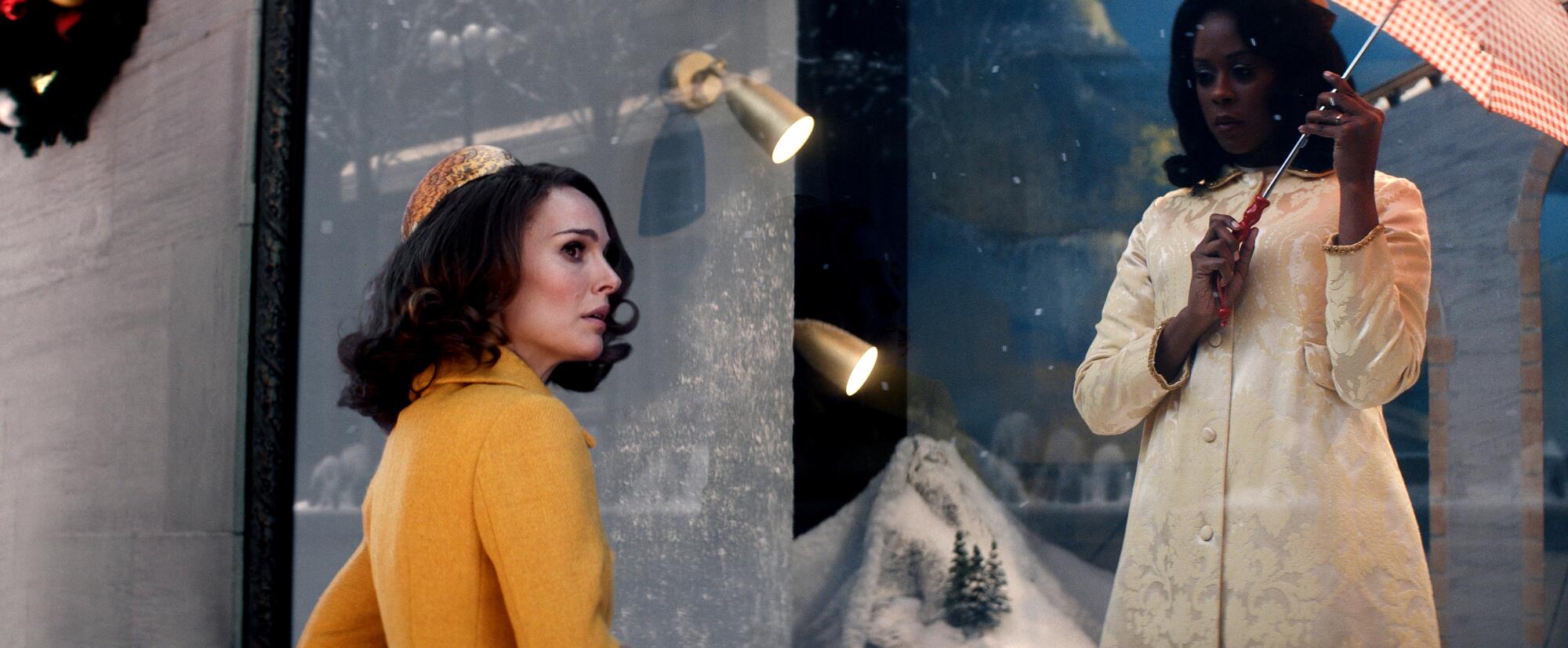
The moment Maddie (Natalie Portman) and Cleo (Moses Ingram) first meet in “Lady in the Lake.”
(Apple TV+)
And yet, the series takes pains to connect them, thematically and visually, in the editing process, through crosscutting that links them throughout different periods of their lives.
“I think they’re living in a very similar world that’s affecting them both in similar ways,” Ingram said. “Being women, being mothers, taking care of the husband and the children and also trying to figure out what they might want for themselves, let alone how to get it — those are all things they share.”
In the series, Maddie is a bit softer than she is in the novel, a little less single-minded in the way she uses Cleo’s story to establish a journalism career. But she’s still deeply flawed and somewhat blind to the lives she writes about. (Lippman: “I joke that if you want to be a human-interest writer, it helps to have some interest in humans”).
For Portman, the fact that Maddie is no angel made the role more interesting, and more human.
“It speaks to the tragedy of the fact that, even if you’re oppressed, you can still be an oppressor,” she says. “That’s something that we have to be very conscious of, because I think the opposite story is usually told: ‘Oh, if someone did something to you, you don’t do it to someone else.’ And that’s just unfortunately not very true.”
For Lippman, a somewhat kinder, gentler Maddie speaks to the different roads taken in a different medium. And she’s quite happy with the results.
“Natalie Portman’s Maddie is much bigger, much more layered and complicated than my Maddie,” she said. “How can I not love that? There’s a big difference between asking readers to come along with a not particularly likable character and asking people to watch that character in a limited series, especially if it’s a female. I really respect the choices made in this adaptation, because they’re thoughtful.”

Movie Reviews
Movie Review: A Home Invasion turns into a “Relentless” Grudge Match

I’d call the title “Relentless” truth in advertising, althought “Pitiless,” “Endless” and “Senseless” work just as well.
This new thriller from the sarcastically surnamed writer-director Tom Botchii (real name Tom Botchii Skowronski of “Artik” fame) begins in uninteresting mystery, strains to become a revenge thriller “about something” and never gets out of its own way.
So bloody that everything else — logic, reason, rationale and “Who do we root for?” quandary is throughly botched — its 93 minutes pass by like bleeding out from screwdriver puncture wounds — excruciatingly.
But hey, they shot it in Lewiston, Idaho, so good on them for not filming overfilmed Greater LA, even if the locations are as generically North American as one could imagine.

Career bit player and Lewiston native Jeffrey Decker stars as a homeless man we meet in his car, bearded, shivering and listening over and over again to a voice mail from his significant other.
He has no enthusiasm for the sign-spinning work he does to feed himself and gas up his ’80s Chevy. But if woman, man or child among us ever relishes anything as much as this character loves his cigarettes — long, theatrical, stair-at-the-stars drags of ecstacy — we can count ourselves blessed.
There’s this Asian techie (Shuhei Kinoshita) pounding away at his laptop, doing something we assume is sketchy just by the “ACCESS DENIED” screens he keeps bumping into and the frantic calls he takes suggesting urgency of some sort or other.
That man-bunned stranger, seen in smoky silhoutte through the opaque window on his door, ringing the bell of his designer McMansion makes him wary. And not just because the guy’s smoking and seems to be making up his “How we can help cut your energy bill” pitch on the fly.
Next thing our techie knows, shotgun blasts are knocking out the lock (Not the, uh GLASS) and a crazed, dirty beardo homeless guy has stormed in, firing away at him as he flees and cries “STOP! Why are you doing this?”
Jun, as the credits name him, fights for his PC and his life. He wins one and loses the other. But tracking his laptop and homeless thug “Teddy” with his phone turns out to be a mistake.
He’s caught, beaten and bloodied some more. And that’s how Jun learns the beef this crazed, wronged man has with him — identity theft, financial fraud, etc.
Threats and torture over access to that laptop ensue, along with one man listing the wrongs he’s been done as he puts his hostage through all this.
Wait’ll you get a load of what the writer-director thinks is the card our hostage would play.
The dialogue isn’t much, and the logic — fleeing a fight you’ve just won with a killer rather than finishing him off or calling the cops, etc. — doesn’t stand up to any scrutiny.
The set-piece fights, which involve Kinoshita screaming and charging his tormentor and the tormentor played by Decker stalking him with wounded, bloody-minded resolve are visceral enough to come off. Decker and Kinoshita are better than the screenplay.
A throw-down at a gas-station climaxes with a brutal brawl on the hood of a bystander’s car going through an automatic car wash. Amusingly, the car-wash owners feel the need to do an Idaho do-si-do video (“Roggers (sic) Car Wash”) that plays in front of the car being washed and behind all the mayhem the antagonists and the bystander/car owner go through. Not bad.
The rest? Not good.
Perhaps the good folks at Rogers Motors and Car Wash read the script and opted to get their name misspelled. Smart move.

Rating: R, graphic violence, smoking, profanity
Cast: Jeffrey Decker, Shuhei Kinoshita
Credits:Scripted and directed by Tom Botchii.. A Saban Entertainment release.
Running time: 1:34
Related
Entertainment
Inga Ibsdotter Lilleaas breaks out in ‘Sentimental Value.’ But she isn’t interested in fame

One of the most moving scenes in Joachim Trier’s “Sentimental Value” happens near the end. During an intense moment between sisters Nora (Renate Reinsve) and Agnes (Inga Ibsdotter Lilleaas), who have both had to reckon with the unexpected return of their estranged father, Gustav (Stellan Skarsgård), Agnes suddenly tells Nora, “I love you.” In a family in which such direct, vulnerable declarations are rare, Agnes’ comment is both a shock and a catharsis.
The line wasn’t scripted or even discussed. Lilleaas was nervous about spontaneously saying it while filming. But it just came out.
“[In] Norwegian culture, we don’t talk so much about what we’re feeling,” explains Lilleaas, who lives in Oslo but is sitting in the Chateau Marmont lounge on a rainy afternoon in mid-November. If the script had contained that “I love you” line, she says, “It would’ve been like, ‘What? I would never say that. That’s too much.’ But because it came out of a genuine feeling in the moment — I don’t know how to describe it, but it was what I felt like I would want to say, and what I would want my own sister to know.”
Since its Cannes premiere, “Sentimental Value” has been lauded for such scenes, which underline the subtle force of this intelligent tearjerker about a frayed family trying to repair itself. And the film’s breakthrough performance belongs to the 36-year-old Lilleaas, who has worked steadily in Norway but not often garnered international attention.
Touted as a possible supporting actress Oscar nominee, Lilleaas in person is reserved but thoughtful, someone who prefers observing the people around her rather than being in the spotlight. Fitting, then, that in “Sentimental Value” she plays the quiet, levelheaded sister serving as the mediator between impulsive Nora and egotistical Gustav. Lilleaas has become quite adept at doing a lot while seemingly doing very little.
“In acting school, some of the best characters I did were mute,” she notes. “They couldn’t express language, but they were very expressive. It was freeing to not have a voice. Agnes, she’s present a lot of the time but doesn’t necessarily have that many lines. To me, that’s freedom — the [dialogue] very often comes in the way of that.”
Inga Ibsdotter Lilleaas in “Sentimental Value.”
(Kasper Tuxen)
Lilleaas hadn’t met Trier before her audition, but they instantly bonded over the challenges of raising young kids. And she sparked to the script’s examination of parents and children. Unlike restless Nora, Agnes is married with a son, able to view her deeply flawed dad from the vantage point of both a daughter and mother. Lilleaas shares her character’s sympathy for the inability of different generations to connect.
“A lot of parents and children’s relationships stop at a point,” she says. “It doesn’t evolve like a romantic relationship, [where] the mindset is to grow together. With families, it’s ‘You’re the child, I’m the parent.’ But you have to grow together and accept each other. And that’s difficult.”
Spend time with Lilleaas and you’ll notice she discusses acting in terms of human behavior rather than technique. In fact, she initially studied psychology. “I’ve always been interested in the [experience] of being alive,” she says. “Tremendous grief is very painful, but you can only experience that if you have great love. I’ve tried the more psychological approach of studying people, but it wasn’t what I wanted. Acting is the perfect medium for me to explore life.”
Other out-of-towners might be disappointed to arrive in sunny Southern California only to be greeted by storm clouds, but Lilleaas is sanguine about the situation. “I could have been at the beach, but it’s fine,” she says, amused, looking out the nearby windows. “I can go to the movies — it’s perfect movie weather.”


Inga Ibsdotter Lilleaas. (Evelyn Freja / For The Times)
Her measured response to both her Hollywood ascension and a rainy forecast speak to her generally unfussed demeanor. During our conversation, Lilleaas’ candor and lack of vanity are striking. How often does a rising star talk about being happy when a filmmaker gives her fewer lines? Or fantasize about a life after acting?
“Some days I’ll be like, ‘I want to give it up. I want to have a small farm,’” she admits. “We lived on a farm and had horses and chickens when I grew up. I miss that. But at the same time, I need to be in an urban environment.”
She gives the matter more thought, sussing out her conflicted feelings. “Maybe as I grow older and have children, I feel this need to go back to something that’s familiar and safe,” she suggests. “I think that’s why I’m searching for small farms [online] — that’s, like, a dream thing. I need some dreams that they’re not reality — it’s a way to escape.”
Lilleaas may have decided against becoming a psychologist, but she’s always interrogating her motivations. This desire for a farm is her latest self-exploration, clarifying for her that she loves her profession but not the superficial trappings that accompany it.
“Ten years ago, this would maybe have been a dream, what’s happening now,” she says, gesturing at her swanky surroundings. “But you realize what you want to focus on and give value. I don’t necessarily want to give this that much value. I appreciate it and everything, but I don’t want to put my heart in it, because I know that it goes up and down and it’s not constant. I put my heart in this movie. Everything that comes after that? My heart can’t be in that.”
Movie Reviews
403 Forbidden
Forbidden
Access to this resource on the server is denied!
Proudly powered by LiteSpeed Web Server
Please be advised that LiteSpeed Technologies Inc. is not a web hosting company and, as such, has no control over content found on this site.
-

 World1 week ago
World1 week agoHamas builds new terror regime in Gaza, recruiting teens amid problematic election
-

 News1 week ago
News1 week agoFor those who help the poor, 2025 goes down as a year of chaos
-

 Business1 week ago
Business1 week agoInstacart ends AI pricing test that charged shoppers different prices for the same items
-

 Health1 week ago
Health1 week agoDid holiday stress wreak havoc on your gut? Doctors say 6 simple tips can help
-

 Technology1 week ago
Technology1 week agoChatGPT’s GPT-5.2 is here, and it feels rushed
-

 Politics1 week ago
Politics1 week agoThe biggest losers of 2025: Who fell flat as the year closed
-

 Science1 week ago
Science1 week agoWe Asked for Environmental Fixes in Your State. You Sent In Thousands.
-

 Business1 week ago
Business1 week agoA tale of two Ralphs — Lauren and the supermarket — shows the reality of a K-shaped economy


